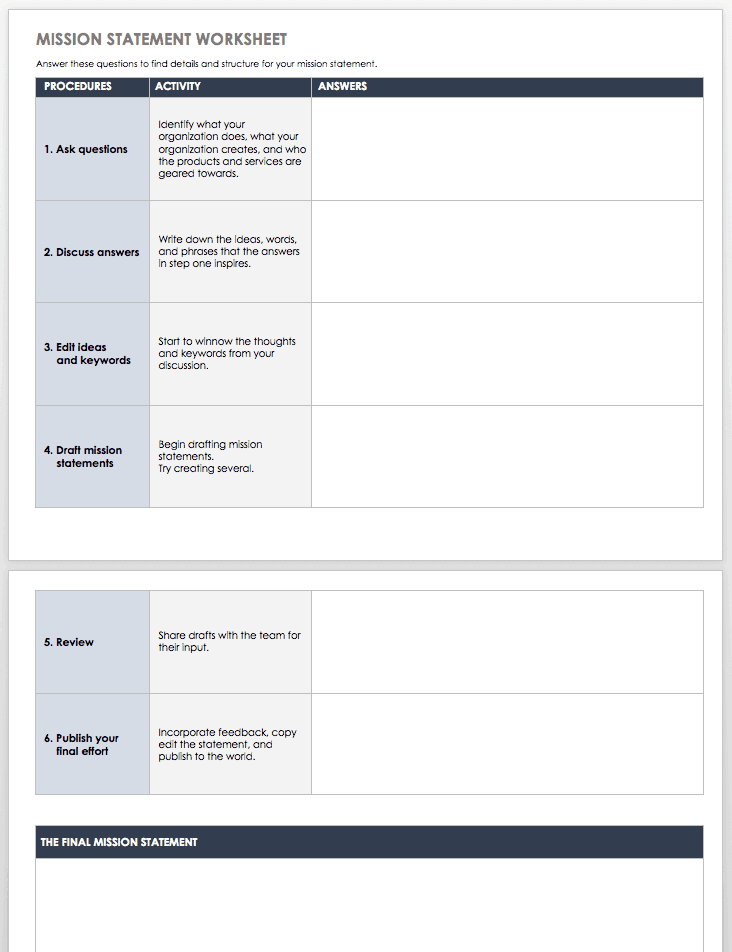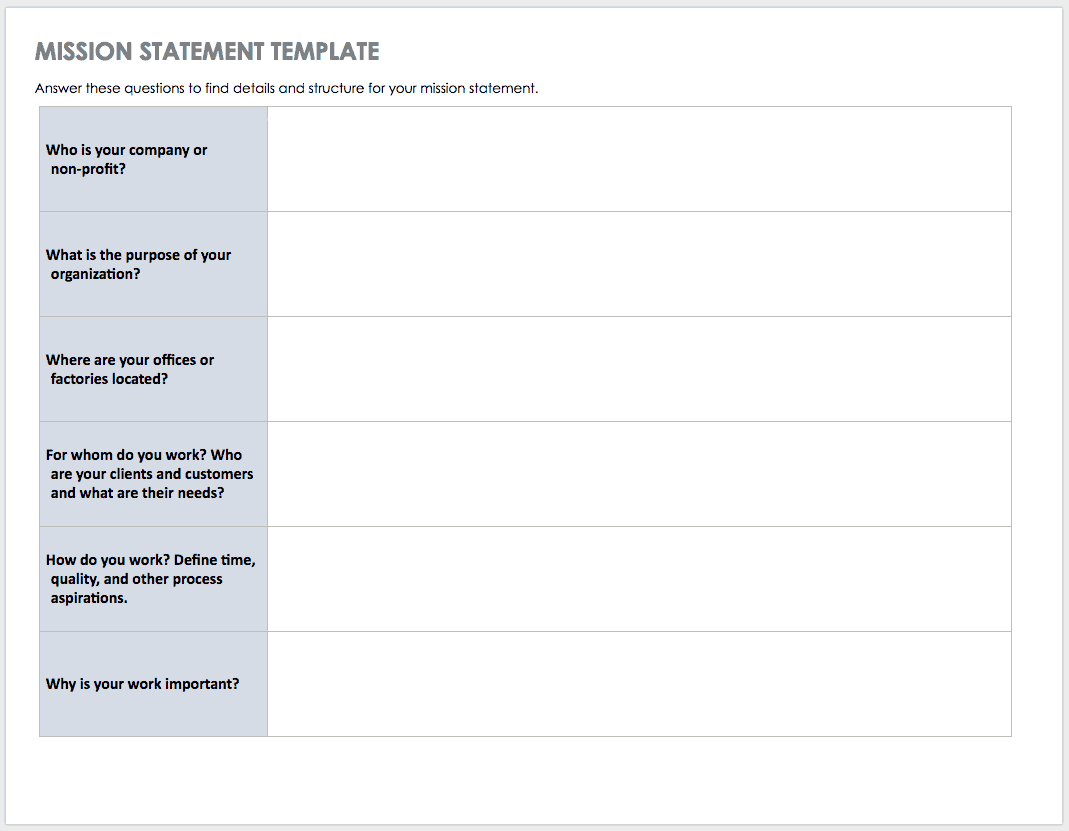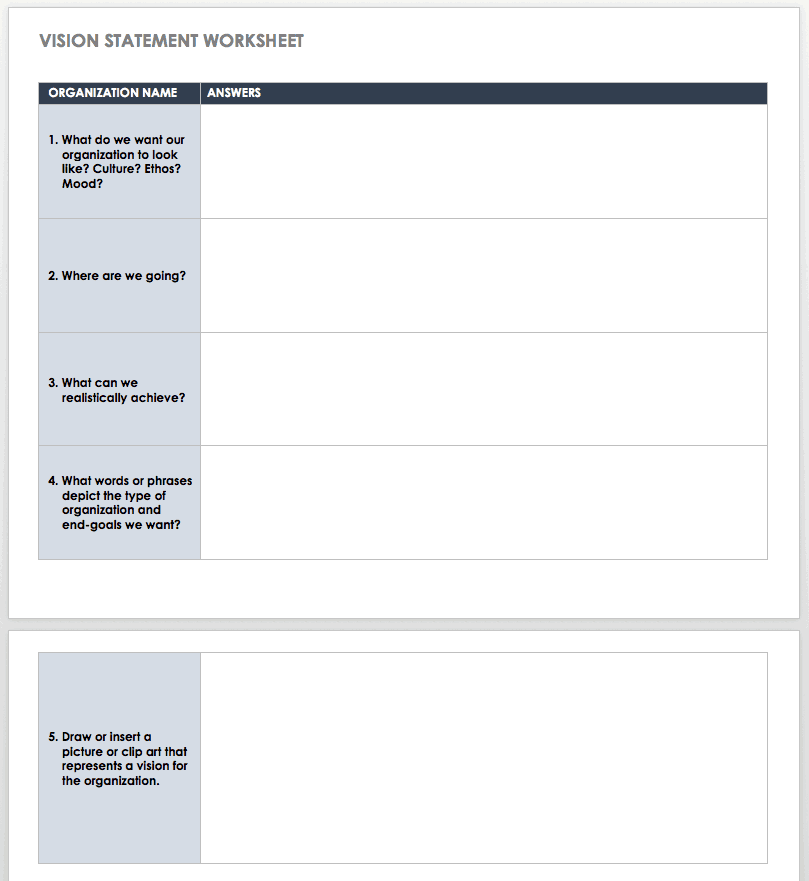Mission Statement Worksheet Template
Download Mission Statement Worksheet Template
The mission statement worksheet will help you gather the information, ideas, words, and phrases to generate a mission statement. You can share the template solely within your organization or with clients, customers, directors, suppliers, and others who can help shape your message.
Mission Statement Template
Download Mission Statement Template
This mission statement template presents a series of who, what, why, and how questions to explore your organization’s function, clients, and purpose. It is available in Word and Google Docs formats, so you can easily save it to your Google Drive and share with relevant parties.
Vision Statement Worksheet Template
Download Vision Statement Worksheet Template
Print or share this vision statement worksheet to gather ideas from employees, clients, and other stakeholders about what your organization’s vision should be. This template includes space for users to draw or insert an image of their vision for the organization.
What Is a Mission Statement of a Company?
A mission statement is a quick, succinct, memorable way of communicating a business or nonprofit’s unique purpose, function, and day-to-day goals to employees, clients, and other stakeholders. Mission statements are usually part of the business plan and often form part of the executive summary. Functioning in such capacities, mission statements can become the summation of a business strategy.
What Is a Vision Statement?
A vision statement describes the ultimate goals and overarching purpose of a for-profit or nonprofit organization. A vision statement can serve as the cornerstone of strategic planning, providing an organization with direction and a general destination as well as defining its aspirations and values. Some say that the vision statement is what would remain if an organization could no longer produce a particular product or service.
Mission Statement Examples for Businesses
Following are some examples of mission statements for for-profit companies:
- Warby Parker: Warby Parker was founded with a rebellious spirit and a lofty objective: to offer designer eyewear at a revolutionary price while leading the way for socially conscious businesses.
- American Express: We work hard every day to make American Express the world's most respected service brand.
- Workday: Workday was founded on a disruptive idea: to put people at the center of enterprise software.
- Disney: Our mission is to be one of the world’s leading producers and providers of entertainment and information. Using our portfolio of brands to differentiate our content, services, and consumer products, we seek to develop the most creative, innovative, and profitable entertainment experiences and related products in the world.
- Louis Vuitton: The mission of the LVMH group is to represent the most refined qualities of Western “Art de Vivre” around the world. LVMH must continue to be synonymous with both elegance and creativity. Our products, and the cultural value they embody, blend tradition and innovation and kindle dream and fantasy.
- Tesla: Tesla’s goal is to accelerate the world’s transition to sustainable energy.
- Starbucks: To inspire and nurture the human spirit — one person, one cup, and one neighborhood at a time.
Mission Statement Examples for Nonprofits
- NPR: The mission of NPR is to work in partnership with Member Stations to create a more informed public — one challenged and invigorated by a deeper understanding and appreciation of events, ideas and cultures.
- Doctors Without Borders (Médecins Sans Frontières [MSF]): MSF was created in the belief that all people should have access to healthcare regardless of gender, race, religion, creed, or political affiliation and that people’s medical needs outweigh respect for national boundaries.
- The Leukemia & Lymphoma Society (LLS): Cure leukemia, lymphoma, Hodgkin’s disease, and myeloma, and to improve the quality of life of patients and their families.
- Heifer International: Heifer International’s mission is to work with communities to end hunger and poverty and to care for the Earth.
- The New York Public Library: The mission of the New York Public Library is to inspire lifelong learning, advance knowledge, and strengthen our communities.
- Livestrong: We improve the lives of people affected by cancer, now.
- Ted Talks: TED is a nonprofit devoted to spreading ideas, usually in the form of short powerful talks (18 minutes or less).
Example Business Vision Statements
Here are some examples of business vision statements:
- Patagonia: Build the best product, cause no unnecessary harm, and use business to inspire and implement solutions to the environmental crisis.
- IKEA: At IKEA our vision is to create a better everyday life for the many people.
- Boeing: People working together as a global enterprise for aerospace industry leadership.
- BBC: The BBC’s vision is to be the most creative organisation in the world.
- Ben & Jerry’s: Making the best ice cream, in the nicest possible way.
- Progressive: Progressive’s vision is to reduce the human trauma and economic costs associated with automobile accidents.
- ASOS: Our vision is to become the world’s number-one destination for fashion-loving 20-somethings.
Example Nonprofit Vision Statements
Here are some examples of nonprofit vision statements:
- VFW: Our vision is to ensure that veterans are respected for their service, always receive their earned entitlements, and are recognized for the sacrifices they and their loved ones have made on behalf of this great country.
- Amnesty International: Amnesty International’s vision is of a world in which every person enjoys all of the human rights enshrined in the Universal Declaration of Human Rights and other international human rights instruments.
- ASPCA: Our organization was founded on the belief that animals are entitled to kind and respectful treatment at the hands of humans and must be protected under the law.
- Cleveland Clinic: We strive to be the world’s leader in patient experience, clinical outcomes, research, and education.
- Ducks Unlimited: The vision of Ducks Unlimited is wetlands sufficient to fill the skies with waterfowl today, tomorrow and forever.
- Habitat for Humanity: A world where everyone has a decent place to live.
- Human Rights Campaign (HRC): The Human Rights Campaign envisions a world where lesbian, gay, bisexual, transgender, and queer people are embraced as full members of society at home, at work, and in every community.
Looking for ways to keep your remote workforce connected?
Download our latest ebook to discover the top 10 helpful tips to establish and maintain company culture across your distributed teams.
What Is the Difference Between a Mission Statement and a Vision Statement?
A mission statement describes the purpose and day-to-day effort of an organization. A vision statement describes an organization’s ultimate goal or future outcome. But the two work in tandem: A vision statement expresses what you ultimately want to achieve; a mission statement articulates what you will do to get there.
Together, the mission and vision statements provide direction and destination. (You outline the actual specifics of how to achieve a mission or vision when discussing goals and objectives.) The terms mission statement and vision statement are sometimes used interchangeably. In addition, people sometimes substitute the word mantra for the term mission statement. However, strictly speaking, a mantra refers to a value-loaded slogan.
Senior managers usually craft mission and vision statements for an organization. Managers at other levels may prepare mission or vision statements for specific departments or programs.
What Are the Benefits of Mission and Vision Statements?
Mission and vision statements chart a path for pursuing consistent quality and values (i.e., the things that will keep your core clients loyal over the years). A mission statement provides a guidepost for your employees, helping them to prioritize efforts, especially in times of crisis or indecision. A mission statement even gives them a way to promote your organization, including to future employees. A mission statement also becomes part of your branding and advertising, offering a quick, clear message for social media and other platforms. Therefore, it’s crucial to be precise in creating a message so that it isn’t vulnerable to interpretation. To craft an effective mission statement, you must view it as a living reference and not merely as a dusty printout on a cubicle wall.
Vision statements provide a common goal for all organization members and stakeholders. They supply a strategic framework for management and inspire employees, guiding them toward ethical operational decisions. Along with mission statements, vision statements also arm employees with a communication tool for reaching stakeholders outside the organization. But mission and vision statements aren’t just for the cafeteria and the boardroom — consider sharing them with clients and potential clients on social media, on packaging, on company swag, and elsewhere.
Should Mission and Vision Statements Ever Change?
Opinions vary widely on whether you should ever change mission or vision statements. Because both of these statements define an organization’s purpose, goals, culture, ethics, and decision-making framework, some experts say they should never change — they believe that although goals may change as you achieve them, mission and vision statements (if written properly) should remain the same. Other sources suggest that a mission statement should cover a limited time (two to 10 years), but that a vision statement, capturing the values of an organization, should remain the same. Still, others feel that a vision statement should change because, ideally, a company should ultimately achieve its long-term goals. Of course, if your organization undergoes radical changes, you will, undoubtedly, want to update either or both statements.
What Needs to Be in a Mission Statement?
A mission statement should include a description of what your organization does, who your clients are, how you fulfill the company’s purpose, and what that purpose is. Ideally, in 30 seconds or less, your readers should understand what the organization offers customers, clients, employees, managers, owners, and potentially even the community and the planet. The statement should also communicate how the company achieves this.
When crafting a mission statement, consider focusing on one or two key functions that can define the organization for employees, external stakeholders, and the public. A mission statement must be as short as possible while still being memorable and lucid in communicating your organization’s purpose. Some experts advise creating a two to six-word tagline, along with mission statements that are longer than 15 words. You may have a longer version for internal use and a shorter, customer-facing version. You may also have bullet points for each area of focus.
Once you’ve created a draft, ask yourself if it could apply to any business or non-profit or if it successfully captures your organization’s uniqueness. Define the essence of your organization and what makes it distinctive.
Buzzwords and Jargon to Cut from Your Mission and Vision Statements
Anybody can throw a lofty sentiment into a statement and then forget about it, or speak in obscure technical terms. Avoid these pitfalls and communicate your organization’s uniqueness directly and clearly. Eliminate phrases such as the following from your copy, and focus on concrete descriptions and aspirations:
- World class
- Superior customer service
- Be the best possible
- To maximize investor returns
- Satisfying
- Highly valued
Look for other bloated, generic words and phrases that you can delete from your message.
How Do You Create an Effective Mission Statement?
Depending on the nature of your organization, you may start researching and drafting a mission statement on your own or with a small group of team members. Remember that if you begin on your own, the development process should not continue in isolation. You’ll get the best result if you both include at least a few stakeholders in the drafting and review process and get buy-in from all those concerned. Here are steps for creating an effective mission statement:
-
Consider reviewing mission statements from organizations similar to yours to see what you like and what approaches are relevant for you.
-
Sit down and write or brainstorm as a group. Make a list of keywords and phrases that describe your organization. Or, you can do the following:
- Write down your organization’s main purpose and function as well as its unique strengths. What is it that we do? What do we create? Why does it matter? How does it make a difference?
- List by type your organization’s main clients, or target buyer personas, internal or external. Detail what good the organization provides for each type of client.
- Describe how the organization treats employees, but only if you intend to pursue respectful and unique treatment.
- Describe the returns and advantages for business owners or non-profit managers and directors. What do you want to gain from the organization? Profits? A happy, productive workforce?
-
List these characteristics in order of importance to your organization.
-
Use these characteristics to create a short paragraph of no more than five or six sentences.
-
Get feedback on this paragraph, not only from employees and other internal stakeholders, but from suppliers, clients, and customers. Will your employees support this statement? Do outsiders believe it accurately reflects your organization?
-
Consolidate your paragraphs into one concise statement. Although the ideal mission statement is 20 or fewer words, keep in mind that a longer message (anywhere from 50 to 250 words) is perfectly acceptable as long as it is impactful. Remember that you can always make it shorter and punchier at some point in the future.
-
Share the final product with everyone. Post it on the wall in the lobby. Tweet it. Add it to your webpage. Consider all the ways you can publish your new mission statement.
As one final step, consider noting every place that your mission statement is published. That way, if you have to update your message, you can disseminate it everywhere simultaneously and include an explanation as to why.
What to Include in a Vision Statement?
Vision statements should be short (usually no longer than two sentences), memorable, aspirational, and compelling. The average length ranges from 10 to 15 words (a vision statement of 30 words would be considered long). Aim for fewer than 20 words, and then see if you can pare down the statement even further.
A vision statement should describe your organization’s unique aspirations and should, therefore, be precise. It should also align with your values. Because a vision statement depicts the broad, long-term vision, it should present optimistic, but realistic expectations — that is, ones that your employees can reasonably work with. Above all, the values that you convey must be relatable for your employees, directors, investors, and customers. Here’s what to include in a vision statement:
- Focus on the Future: Describe your aspirations for how the organization should look and feel in the future and what it should accomplish.
- Specify a Clear Vision: Provide direction that’s clear and focused enough to shape decision making. Make the statement concise and easy to read and remember. Some sources suggest focusing on one objective. If you must elaborate, do it in an additional document.
- Make the Scope Broad: At the same time, a vision should be general enough to encompass changing possibilities.
- Make It Achievable: A vision shouldn’t be so abstract and lofty as to never be attainable.
- Make It Inspiring: Members of your organization and outside stakeholders should be inspired to extend themselves and organization resources in order to achieve a greater goal.
- Find Something Stable: Your vision statement should define a goal that has a reasonable expectation of success despite economic, technological, or other shifts.
- Pinpoint a Date: Specify the future date by which the company should have achieved the goal.
- Include Relevant Goals and Values: Ensure that the statement applies to current and foreseeable efforts and challenges.
What Makes Your Organization Unique? Define what differentiates your company from all other organizations and why that quality is crucial to both internal stakeholders and clients.
How Do You Create a Compelling Vision Statement?
Just as you might collaborate to create a mission statement, consider working as a group to research and draft a vision statement. And, ask your internal and external stakeholders to review the draft statement before you commit to a final version. Here are the steps to creating a compelling vision statement:
-
Write down your organization’s main purpose and function. Convey how you help clients or customers.
-
List keywords and phrases that describe your vision for your organization.
-
Describe what is unique about your organization’s approach to its primary purpose.
-
Send your draft out for review.
-
Publish the final version.
Vision Statement Template
Are you holding back from drafting a vision statement? This template gives you a sentence format, so you can simply add the words that best sum up your vision for your organization. But don’t write just one — use the template to write several iterations until you hone in on the words and ideas that work best.
Download Vision Statement Template
Improve Mission and Vision Statement Templates with Smartsheet
Empower your people to go above and beyond with a flexible platform designed to match the needs of your team — and adapt as those needs change.
The Smartsheet platform makes it easy to plan, capture, manage, and report on work from anywhere, helping your team be more effective and get more done. Report on key metrics and get real-time visibility into work as it happens with roll-up reports, dashboards, and automated workflows built to keep your team connected and informed.
When teams have clarity into the work getting done, there’s no telling how much more they can accomplish in the same amount of time. Try Smartsheet for free, today.


